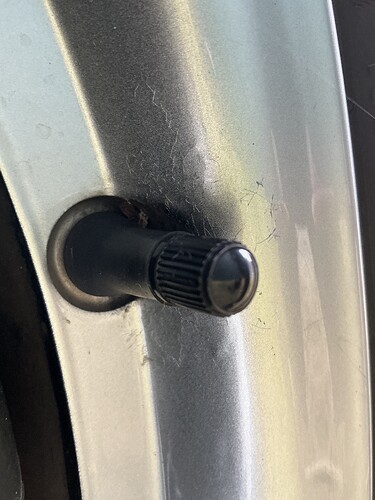I washed our 2011 NC for the first time in months yesterday (bad owner!) and noticed this cracking in the surface of just one of the alloys. I suspect it’s the thin end of the corrosion wedge, although both rear shocks were replaced since I last washed the car. So what is the best course of action to either remedy things or stop it spreading? It’s mainly my wife’s daily and she’s not inclined to spend money on cosmetic issues with it. So I either need to give her a good argument to spend an appropriate sum of money (what would it be ballpark?) or have a cheap nip-it-in-the-bud (as is) or slow-it-down solution.
Probably up to £250 per set for a refurb (depending where, who etc) but doing one may make it stand out from the others.
Personally I’d try and touch it up or just leave it as is.
Have the alloys been refurbished before, at first sight it looks like corrosion, a closer look and it could be flaking paint from a previous paint over?
Agree with MickAP wheel has been resprayed in the past and the paint is now cracking.
Around my way a full set of 17" wheels will cost you about 180 pounds plus 10 each for tyre remove and refit. About 220 total.
Thanks. So what’s the best way of matching a touch up paint to my specific alloys. They are the original Mazda alloys that came with the car, and, as far as I can tell, they haven’t been sprayed.
I would disagree that it was any form of repair. The valve area is where brake dust is hard to clean. I would expect some harsh cleaning agent has been used, probably before sale.
Keep them regularly clean and also use a regular sealant, which car cleaning people can recommend.
Secondly, stop looking, it will just depress you!
This^
Personally, FinishKare 100p or (even better esp longevity) Bouncer’s Sicure
Thanks. I found Bouncer’s SiCure, but not FinishKare 100p. Did you mean FinishKare 1000p wax (for body work)? I suspect you did, but I’m asking on the off chance they have a 100p product for wheels only.
Also, spotted this in the process of looking around. Anyone here used it or knows if it’s as good as the reviews suggest? I’m not a big believer in the accuracy of Amazon reviews. https://amzn.eu/d/1BMGnCz
Assuming they’re original and the car is a 2011, the wheels have done well to only have that small area of corrosion - just be thankful they aren’t diamond cut or there would be lots! I’ve no doubt it’s been chipped somewhere around there when it’s had a tyre and valve change and water got under the finish. You could scratch it off, sand it down, find a colour match etc. But for the money, hassle and time of trying to do it myself I’d much sooner get either one or all wheels refurbished every time. It’s the best way and really isn’t that expensive considering the difference it makes. Wheels make a car in my opinion.
yes, that’s the finishkare. If you read around on google, many people use it on wheels (it’s a high temp wax/sealant). It’s very easy on off. Personally, for longevity, I’d use the Bouncer’s sicure. It’s literally like water. As long as the wheel is pre prepped (cleaned really well, maybe using Garage Therapy zero decon shampoo, and after drying, maybe a fallout remover like Bilt Hamber Korosal, then washing with zero again). This will make it bond better, hence longer longevity. Sicure needs only a few drops (ish) on a yellow applicator pad, and you buff off pretty quickly. I’ve found it then last ages, with just general washing with a mild, ph neutral shampoo.
If you think it is damage, then way more likely an owner battering it with an air line nozzle when adding air.
Thanks, I’ve purchased the Bouncer’s SiCure.
Regarding when/how the damaged occurred. All I know is it wasn’t there last time I washed the wheels (maybe 6 months ago). I use our own air pump carefully from time to time to top up pressure if needed. But I certainly wouldn’t be knocking anything on the wheel as part of that process. The only other thing that’s happened to those wheels (both rear) in the last 6 months, is inevitably they were removed when both rear shocks were replaced (although only one had gone).
So either something happened at that point, or it’s progressive corrosion that really wasn’t obvious in earlier stages. In a way I hope it was related to the changing of the rear shocks, since I can probably treat and halt it now. Plus it’s relatively small and insignificant if it’s going to just be this one area.
But thanks for all the advice and thoughts, at least I now have a plan to treat it….or know the other options and costs.
I had it on my NISMO RS alloys, washed weekly with ph neutral (Autofinese lather) wheel shampoo, sealed regularly. Also, and get this it happened on TWO of the alloys, and BOTH of them were not the original ones ones on the car. One a tyre fitter ate, shocking hack job, so they ordered a new one when I plastered all images of the work on social media and gave a awful google review. The alloy was ordered from NISSAN, brand new etc. That developed that same bubble around the stem after a few years. I’m also uber careful with the air pressure pump. The other alloy I got myself new for one reason or another, think I wanted a full size spare and swapped ones around on new tyre day, and that went the same way after a few years. The two original ones, stayed fine.
